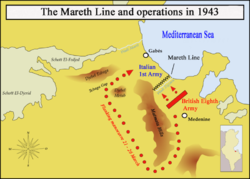
Back خط مارث Arabic Línia Mareth Catalan Marethská linie Czech Mareth-linjen Danish Mareth-Linie German Línea Mareth Spanish Mareth-linja Finnish Ligne Mareth French Linea del Mareth Italian Garis Mareth Malay
| Mareth Line | |
|---|---|
| Part of French defence of Tunisia | |
| Tunisia | |
 Mareth Line in 1943 | |
| Coordinates | 33°38′00″N 10°18′00″E / 33.63333°N 10.30000°E |
| Height | 2,200 ft (670 m) |
| Length | 25 mi (40 km) |
| Site information | |
| Owner | French colonial administration of Tunisia |
| Operator | French army (1939–1940) |
| Controlled by | German–Italian Panzer Army (Deutsch-Italienische Panzerarmee/Armata Corazzata Italo-Tedesca) [1943] |
| Condition | Derelict |
| Site history | |
| Built | 1936 |
| Built by | French colonial administration of Tunisia and French Army |
| In use | March 1943 |
| Materials | reinforced concrete |
| Fate | Abandoned after 1943 |
| Battles/wars | Battle of the Mareth Line |
| Garrison information | |
| Past commanders | Giovanni Messe Erwin Rommel |
| Garrison | 1943, east to west: 136th Infantry Division Giovani Fascisti, 101st Motorised Division Trieste, 90th Light Division, 80th Infantry Division La Spezia, 16th Motorised Division Pistoia, 164th Light Afrika Division 15th Panzer Division (32 operational tanks) Reserve: 21st Panzer Division, 10th Panzer Division (110 operational tanks); Djebel Tebaga to Djebel Melab: Raggruppamento Sahariano |
The Mareth Line was a system of fortifications built by France in southern Tunisia in the late 1930s. The line was intended to protect Tunisia against an Italian invasion from its colony in Libya. The line occupied a point where the routes into Tunisia from the south converged, leading toward Mareth, with the Mediterranean Sea to the east and mountains and a sand sea to the west.
The line ran along the north side of Wadi Zigzaou for about 50 km (31 mi) south-westwards from the Gulf of Gabès to Cheguimi and the Djebel (mountain) Matmata on the Dahar plateau between the Grand Erg Oriental (Great Eastern Sand Sea) and the Matmata hills. The Tebaga Gap, between the Mareth line and the Great Eastern Sand Sea, a potential route by which an invader could outflank the Mareth line, was not surveyed until 1938.
After the French Armistice of 22 June 1940, the Mareth Line was demilitarised under the supervision of an Italo-German commission. Tunisia was occupied by Axis forces after Operation Torch in 1942 and the line was refurbished and extended by Axis engineers into a defensive position by building more defences between the line and Wadi Zeuss 3.5 mi (5.6 km) to the south but French-built anti-tank gun positions were too small for Axis anti-tank guns which had to be sited elsewhere.
The Battle of Medenine (6 March 1943) against the Eighth Army was a costly failure. At the Battle of the Mareth Line (16–31 March 1943) the Eighth Army was contained within the Mareth Line defences. An outflanking move west and north of the Mareth Line was followed by Operation Supercharge II which broke through the Axis defences of the Tebaga Gap and led them to retreat from the Mareth Line to Wadi Akarit. The Mareth Line is derelict and is commemorated at the Mareth Museum.